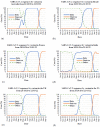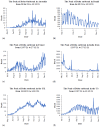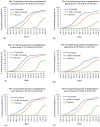Is the SARS CoV-2 Omicron Variant Deadlier and More Transmissible Than Delta Variant?
- PMID: 35457468
- PMCID: PMC9032753
- DOI: 10.3390/ijerph19084586
Is the SARS CoV-2 Omicron Variant Deadlier and More Transmissible Than Delta Variant?
Abstract
Genetic variants of severe acute respiratory syndrome coronavirus (SARS-CoV-2) have been globally surging and devastating many countries around the world. There are at least eleven reported variants dedicated with inevitably catastrophic consequences. In 2021, the most dominant Delta and Omicron variants were estimated to lead to more severity and deaths than other variants. Furthermore, these variants have some contagious characteristics involving high transmissibility, more severe illness, and an increased mortality rate. All outbreaks caused by the Delta variant have been rapidly skyrocketing in infection cases in communities despite tough restrictions in 2021. Apart from it, the United States, the United Kingdom and other high-rate vaccination rollout countries are still wrestling with this trend because the Delta variant can result in a significant number of breakthrough infections. However, the pandemic has changed since the latest SARS-CoV-2 variant in late 2021 in South Africa, Omicron. The preliminary data suggest that the Omicron variant possesses 100-fold greater than the Delta variant in transmissibility. Therefore, this paper aims to review these characteristics based on the available meta-data and information from the first emergence to recent days. Australia and the five most affected countries, including the United States, India, Brazil, France, as well as the United Kingdom, are selected in order to review the transmissibility, severity and fatality due to Delta and Omicron variants. Finally, the vaccination programs for each country are also reviewed as the main factor in prevention.
Keywords: COVID-19; Delta variant; Omicron variant; SARS-CoV-2; severity and mortality; transmissibility; variants of concern.
Conflict of interest statement
The authors declare no conflict of interest.
Figures



















Similar articles
-
Unraveling the Dynamics of Omicron (BA.1, BA.2, and BA.5) Waves and Emergence of the Deltacton Variant: Genomic Epidemiology of the SARS-CoV-2 Epidemic in Cyprus (Oct 2021-Oct 2022).Viruses. 2023 Sep 15;15(9):1933. doi: 10.3390/v15091933. Viruses. 2023. PMID: 37766339 Free PMC article.
-
Comparison of epidemiological characteristics and transmissibility of different strains of COVID-19 based on the incidence data of all local outbreaks in China as of March 1, 2022.Front Public Health. 2022 Sep 15;10:949594. doi: 10.3389/fpubh.2022.949594. eCollection 2022. Front Public Health. 2022. PMID: 36187650 Free PMC article.
-
Molecular evolution of SARS-CoV-2 from December 2019 to August 2022.J Med Virol. 2023 Jan;95(1):e28366. doi: 10.1002/jmv.28366. J Med Virol. 2023. PMID: 36458547 Free PMC article. Review.
-
Overlapping Delta and Omicron Outbreaks During the COVID-19 Pandemic: Dynamic Panel Data Estimates.JMIR Public Health Surveill. 2022 Jun 3;8(6):e37377. doi: 10.2196/37377. JMIR Public Health Surveill. 2022. PMID: 35500140 Free PMC article.
-
Comparison of Omicron and Delta Variants of SARS-CoV-2: A Systematic Review of Current Evidence.Infect Disord Drug Targets. 2024;24(7):e050324227686. doi: 10.2174/0118715265279242240216114548. Infect Disord Drug Targets. 2024. PMID: 38445691
Cited by
-
Evaluation of aerosol transmission risk during home quarantine under different operating scenarios: A pilot study.Build Environ. 2022 Nov;225:109640. doi: 10.1016/j.buildenv.2022.109640. Epub 2022 Sep 29. Build Environ. 2022. PMID: 36210963 Free PMC article.
-
The Impact of Clinical Factors and SARS-CoV-2 Variants on Antibody Production in Vaccinated German Healthcare Professionals Infected Either with the Delta or the Omicron Variant.Vaccines (Basel). 2024 Feb 5;12(2):163. doi: 10.3390/vaccines12020163. Vaccines (Basel). 2024. PMID: 38400146 Free PMC article.
-
Effectiveness of COVID-19 Vaccine Booster Shot Compared with Non-Booster: A Meta-Analysis.Vaccines (Basel). 2022 Aug 25;10(9):1396. doi: 10.3390/vaccines10091396. Vaccines (Basel). 2022. PMID: 36146474 Free PMC article. Review.
-
Preceding anti-spike IgG levels predicted risk and severity of COVID-19 during the Omicron-dominant wave in Santa Fe city, Argentina.Epidemiol Infect. 2022 Nov 3;150:e187. doi: 10.1017/S0950268822001716. Epidemiol Infect. 2022. PMID: 36325837 Free PMC article.
-
Catastrophic thrombotic events with partial bilateral amputation of legs and fingers in a 12-year-old girl with COVID-19 in Brazil: case report.J Vasc Bras. 2024 Aug 9;23:e20230175. doi: 10.1590/1677-5449.202301752. eCollection 2024. J Vasc Bras. 2024. PMID: 39286302 Free PMC article.
References
Publication types
MeSH terms
Supplementary concepts
LinkOut - more resources
Full Text Sources
Medical
Miscellaneous

